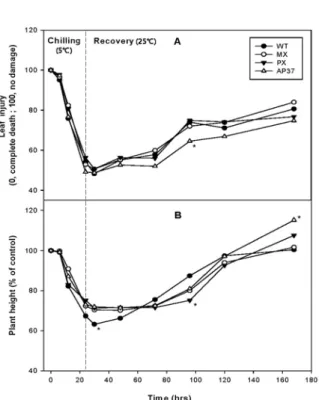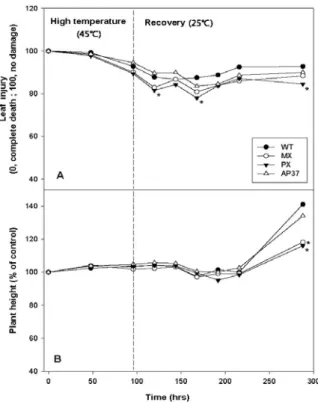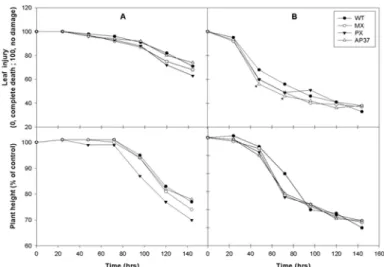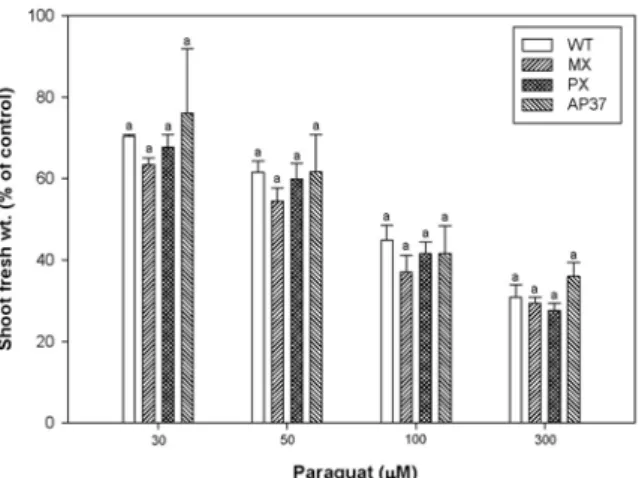www.kwss.or.kr
1순천대학교 생명산업과학대학 자원식물개발학과, 540-742 전남 순천시 중앙로 413(Dept. of Development in Resources, College of Life Science and Natural Resources, Sunchon National University, Suncheon 540-742, Korea).
2전남농업기술원 쌀연구소, 520-715 전남 나주시 산포면 산제리 206-7(Jeonnam Agricultural Research and Extension Service, Naju 520-715, Korea).
3순천대학교 사범대학 농업교육과, 540-742 전남 순천시 중앙로 413(Department of Agricultural Education, Sunchon National University, Suncheon 540-742, Korea).
4코넬대학교 작물 및 토양학과(Department of Crop and Soil Sciences, Cornell University, NY, Ithaca 14853, USA).
* 연락저자(Corresponding author):Phone) +82-61-750-3286, Fax) +82-61-750-3280, E-mail) yikuk@sunchon.ac.kr
(Received February 15, 2012; Examined March 15, 2012; Accepted March 20, 2012)
Ⓒ 2012 Korean Society of Weed Science
Protox 저해형 제초제 저항성 형질전환벼와 비형질전환벼의 환경스트레스에 대한 생리적 반응 차이
윤영범1, 권오도2, 신동영1, 현규환1, 이도진3, 정하일4, 국용인1*
Difference in Physiological Responses to Environmental Stress in Protox Inhibitor Herbicide-Resistant Transgenic Rice
and Non-transgenic Rice
Young Beom Yun
1, Oh-Do Kwon
2, Dong Young Shin
1, Kyu Hwan Hyun
1, Do Jin Lee
3, Ha-Il Jung
4and Yong In Kuk
1*ABSTRACT The objective of this research was to confirm the difference in physiological responses to
environmental stresses such as chilling, high temperature, NaCl, and chemical stress (paraquat) in Protox inhibitor resistant-transgenic rice (MX, PX, and AP37) and its non-transgenic counterpart (WT). Transgenic and non-transgenic rice plants were exposed to a chilling temperature of 5℃ for 1 day or a high temperature of 45℃ for 4 days and allowed to recover at 25℃ for 6 days after the chilling treatment or 8 days after the high temperature treatment. Leaf injury, shoot fresh weight, porphyrin biosynthesis substances, and chlorophyll content were investigated in transgenic and non-transgenic rice at 6 days after 0.5% and 1%NaCl treatments or at 5 days after 0∼300 μM paraquat treatments. No significant difference in leaf injury and shoot fresh weight were observed between transgenic and non-transgenic rice during chilling and recovery. Plant height and shoot fresh weight were also similar between transgenic and non-transgenic rice during the high temperature and recovery period (0∼5 days). However, plant height and shoot fresh weight in transgenic rice line MX and PX were lower than in non-transgenic rice at 6 days for recovery. Leaf injury, chlorophyll, and Mg-Proto IX ME contents had no significant difference between transgenic rice and non-transgenic rice after NaCl treatment, but Proto IX content for AP37 and shoot fresh weight for
PX and AP37 in 0.5% NaCl treatment were significantly reduced compared with non-transgenic rice. There was no difference in leaf injury and shoot fresh weight when comparing transgenic rice and non-transgenic rice after paraquat treatment. Although transgenic rice and non-transgenic rice showed a little difference at a particular measurement period in certain environmental stresses, there was generally no difference in physiological responses between transgenic rice and non-transgenic rice.
Key words: environmental stress; herbicide resistance; protox; transgenic rice.
서 언
쌀은 세계인구의 절반이상이 주식으로 이용하고 있 는 작물로 많은 연구가 진행되고 있으며 재배적 측면 에서 특히 잡초방제 등이 문제시되고 있다. 그 동안 국 내 벼 재배농가에서는 기계이앙 재배를 주로 하고 있 지만 남부지방에서 직파재배 면적이 증가하면서 잡초 방제를 위하여 많은 비용을 부담하고 있는 실정이다.
하지만 제초제 저항성 유전자가 도입된 형질전환 벼를 개발하여 직파재배시 문제시되는 잡초성벼 등과 같은 문제 잡초방제에 사용한다면 많은 노동력과 농약을 효 과적으로 줄일 수 있을 것으로 기대된다.
특히 1960년도부터 상업화된 Protox 저해 제초제는 극미량의 처리로도 제초효과가 탁월하며 빠르게 효과 를 나타낼 뿐만 아니라 비수용성으로 식물체나 토양 입자에 쉽게 흡착되고 광산화에 의해 곧바로 분해되어 잔류독성이 매우 낮아 환경오염을 줄일 수 있는 제초 제이다(Scalla와 Matringe 1994). 또한 Protox 저해 제 초제가 수십 년 동안 사용되어 왔으나 다른 계통(ALS 저해제 등)의 제초제들과 달리 아직까지 Protox 제초 제 연용에 의한 저항성 잡초들이 거의 출현하지 않고 있다(Heap 2011; Komives와 Gullner 1994). 그러나 지 금까지 개발된 많은 Protox 저해 제초제는 선택성 폭 이 매우 좁다. 그래서 이들 제초제들은 과수원에 사용 시 과수가 직접 접촉되지 않도록 국부처리로 제한하고 있으며, 이들 제초제에 상대적으로 내성을 보인 양파, 완두, 목화 등을 제외하고는 식물종간에 선택성이 적 어 작물 생육기에 제초목적으로 사용하기에는 어려운 점이 있다(Scalla와 Matringe 1994).
이들 제초제의 선택성 결여 문제를 해결하기 위하 여 Bacillus subtilis(Ha 등 2003), Arabidopsis thaliana (Ha 등 2004), Homo sapiens(Lee 등 2004) 및 Myxococcus
xanthus(Jung 등 2004) Protox 유전자를 벼에 도입하여
Protox 저해 제초제에 저항성 형질전환벼가 개발되었 다. 이중 Myxococcus xanthus(Jung 등 2004) Protox 유 전자를 발현시키는 형질전환벼는 B. subtilis(Ha 등 2003), A. thaliana(Ha 등 2004) 및 Homo sapiens(Lee 등 2004) Protox 유전자를 발현시킨 형질전환 벼에 비 해 저항성 정도가 높았다. M. xanthus(Jung 등 2008) Protox 유전자를 과다발현시킨 벼는 이앙재배 및 담수 직파재배에서도 Protox 저해제인 oxyfluorfen과 oxadiazon 의 표준량의 2배 이상처리에서도 높은 저항성을 보였 다(Jung 등 2010).
Protox 유전자가 도입된 제초제 저항성 형질전환벼 는 유묘기 때 생육이 다소 떨어지나 생육후반기에 회 복되며, 어떤 제초제 저항성 형질전환벼는 유묘기때 부터 생육기 전반에 걸쳐 생육저해로 인해 수확기에 수량감소가 야기되었다(Kuk 등 2010). 그러나 bar 유 전자가 도입된 제초제 저항성 형질전환벼는 비형질전 환벼를 대상으로 비교한 영양성분에서는 차이가 없다 는 보고(Li 등 2008; Oberdoerfer 등 2005)와 Protox 유 전자가 삽입된 제초제 저항성 형질전환벼는 비형질전 환벼와 일부 양분에서 차이가 있다고 보고하였다(Yun 등 2012).
형질전환작물의 개발과 상업화에 있어서 반드시 이
들 작물의 생육, 수량 및 양분조성뿐만 아니라 환경스
트레스에 대한 반응 및 안전성 평가 등을 선행적으로
수행하여야 한다. 따라서 본 연구는 Protox 저해형 제
초제에 저항성인 형질전환벼와 비형질전환벼간 환경
스트레스(저온, 고온, 염분 등)에 대한 반응차이를 알
아보기 위하여 수행하였다.
재료 및 방법
식물재료
본 연구에 A. thaliana Protox 유전자 과다발현 형질 전환 벼(Ha 등 2004), T4세대 1라인(AP37), M. xanthus Protox 과다발현 형질전환 벼(Jung 등 2004) T8세대 1 라인(MX)과 항생제 저항성 유전자가 없는 M. xanthus Protox 유전자 과다발현 형질전환벼(Kuk 등 2010) T4 세대 1라인(PX)의 종자를 사용하였다.
다양한 환경스트레스에 대한 반응차이
A. thaliana 및 M. xanthus Protox 유전자 과다발현
제초제 저항성 형질전환벼와 비형질전환벼의 환경스 트레스에 대한 반응 차이를 알아보고자 각각의 형질전 환벼와 비형질전환벼의 종자를 25℃에서 4일간 침종 하고 최아시켜 수도용상토가 충진된 소형포트(75mm, Φ × 95mm, H)에 각각 3립의 종자를 파종하여 2엽기 까지 온실조건(주야간의 평균온도 30/25℃, 상대습도 65/80%, 그리고 광주기 14/10시간으로 유지)에서 육묘 하였다.
저온 반응은 5℃의 생장상에서 1일간 둔 후 25℃의 생장상에서 6일간 회복기간을 두었다. 고온에 대한 반 응은 45℃의 생장상에서 4일간 둔 후 8일간 회복기간 을 두었다. 저온과 고온 처리 후 유묘의 회복정도를 파 악하기 위하여 잎의 피해율, 초장 및 지상부 생체중을 경시적으로 조사하였다.
각 Protox 유전자별 형질전환벼의 유묘기 내염성 검 정을 위해 2엽기까지 생육한 벼를 토양으로부터 채취 하여 뿌리를 세척하고 50×50cm 사각포트에 NaCl 농 도가 0, 0.5 및 1%가 되게 만들어 벼를 5cm 간격으로 이앙하고 6일후에 잎의 피해율, 초장 및 생체중을 조 사하였다. 또한 NaCl 처리 48시간 후에 식물체를 수확 하여 porphyrin 중간물질과 엽록소 함량을 조사하였다.
Porphyrin 중간물질 축적은 생육시기별 Protox 유전 자별 저항성 형질전환벼와 비형질전환벼 엽 절편 (100mg)을 막자사발에 넣고 2ml의 methanol:acetone:
0.1N NaOH(9:10:1, v/v/v) 추출용액으로 마쇄한 다 음, 4℃의 온도에서 10,000g의 속도로 10분간 원심분 리하여 상징액을 취하고 나일론 필터(0.2μm pore size) 로 거른 후 사용하기 전까지 -75℃의 냉동고에 보관하 였다. Porphyrin 중간물질인 protoporphyrin Ⅸ(Proto
Ⅸ), Mg-protoporphyrin Ⅸ(Mg-Proto Ⅸ)와 Mg-proto- porphyrin Ⅸ monomethyl ester(Mg-Proto Ⅸ Me)는 Lermontova와 Grimm(2000)의 방법에 의해 분석하였 다. 기타 구체적인 분석방법은 Kuk 등(2010)의 방법에 준하여 실시하였다.
엽록소 함량 측정은 각 생육시기별 형질전환벼와 비형질전환벼의 엽 절편(100mg)을 채취하여 시험관에 넣고 dimethyl sulfoxide(DMSO)를 용매로 하여 48시 간 동안 암상태에서 엽록소를 추출한 다음 분광광도계 로 645와 663nm에서 흡광도를 측정하여 엽록소 함량 을 계산하였다(Hiscox와 Israelstam 1979).
Chemical 스트레스에 대한 반응을 알아보기 위하여 활성산소를 생성하는paraquat를 0, 10, 50, 100, 300μM 농도로 3엽기 벼에 처리하고 5일 후에 잎의 피해율과 생체중을 조사하였다.
통계처리
본 실험은 완전임의 배치 3반복으로 하였으며, 통계 처리는 최소유의차 검정(P=0.05)을 실시하여 유의성 유무를 확인하였다(SAS 2000).
결과 및 고찰
다양한 환경 스트레스에 대한 반응 차이
Protox 저해형 제초제에 저항성으로 밝혀진 형질전
환벼(Jung 등 2008; Kuk 등 2010)에 대한 환경반응 차
이를 알아보기 위하여 형질전환벼(MX, PX, AP 37)와
비형질전환벼의 종자를 파종하여 2엽기까지 생육한
후 5℃의 생장상에서 24시간 둔 후 25℃의 생장상으로
옮긴 후 24∼168시간(7일)까지 벼의 피해율과 초장의
변화를 조사하였다(그림 1). 저온기간 동안 달관평가
에 의한 벼의 피해율은 형질전환벼 라인과 WT간에 차
이가 없었다. 저온처리 후 회복기간 96시간째에는
AP37에서 WT에 비해 잎에 피해율이 심했을 뿐 다른
회복기간(30, 48, 72, 120 및 168시간)에서는 형질전환
벼 라인과 WT간에 유의적인 차이는 없었다. 한편 초
장의 경우에서도 저온처리기간에는 형질전환벼 라인
과 WT간에 차이가 없었고, 저온처리 후 회복기간에서
는 AP37의 30시간째, PX의 96시간째 및 AP37의 168
시간째에 WT에 비해 유의적인 차이가 있었을 뿐 전반
Fig. 1. Changes in (A) leaf injury and (B) plant height in wild type and transgenic rice lines during chilling and recovery.
WT, wild type; MX, M. xanthus Protox transgenic lines; PX, M. xanthus Protox transgenic lines of marker free; AP37, Arabidopsis Protox transgenic lines. * is significantly different at 5% level according to Duncan's Multiple Range Test.
Fig. 2. Changes in shoot fresh weight in wild type and transgenic rice lines at 5℃ for 1 day followed by 25℃ for 6 days.
WT, wild type; MX, M. xanthus Protox transgenic lines; PX, M. xanthus Protox transgenic lines of marker free; AP37, Arabidopsis Protox transgenic lines. Means within columns followed by the same letters are not significantly different at 5% level according to Duncan's Multiple Range Test.
적으로 형질전환벼 라인과 WT간에 차이가 없었다. 또 한 저온처리 후 회복 168시간째에 조사한 생체중은 형 질전환벼 라인과 WT간에 유의적인 차이가 없었다(그 림 2).
위의 저온실험과 유사하게 2엽기까지 생육한 형질 전환벼 라인과 WT벼를 45℃의 생장상에서 96시간 처 리하고 25℃의 생장상에서 96∼288시간(12일)까지 처 리하여 고온과 고온처리 후 회복정도를 달관평가에 의 한 잎에 피해율과 초장감소로 알아보았다(그림 3). 고 온기간 동안에는 형질전환벼 라인과 WT간에 잎의 피 해율에 대한 차이는 보이지 않았다. 고온처리 후 회복 기간 동안 잎의 피해율은 PX의 120시간째에, MX와 PX의 168시간과 192시간째 그리고 PX의 288시간째 에 WT에 비해 많았다. 그러나 초장의 경우에는 고온 과 고온처리 후 회복기간 216시간까지는 형질전환 라 인과 WT간에 유의적인 차이가 없었으나 회복 288시 간째에 MX와 PX는 WT에 비해 초장의 감소가 컸다.
한편 회복 최종일(288시간)에 조사한 생체중은 형질전 환벼 라인 MX와 PX는 WT에 비해 유의적으로 적었 으나 AP37과 WT간에 유의적인 차이가 없었다(그림 4). 이상의 결과로 볼 때 형질전환벼 MX와 PX는 고온 에 대한 안정성이 WT에 비해 떨어지는 것으로 나타났 다. 따라서 추후에 이들 라인에서 고온에 대한 안정성 이 어떤 기작에 의해 떨어지는지에 대한 구체적인 연 구가 병행되어야 할 것이다.
Protox 과다발현 형질전환벼 라인과 비형질전환벼 종자를 파종하여 2엽기까지 육묘하여 뿌리를 세척한 후 NaCl 0, 0.5% 및 1%가 들어 있는 test tube에 넣어 144시간까지 생장상에 두면서 달관평가에 의한 잎 피 해율, 초장 및 지상부 생체중을 조사하였다(그림 5와 6). 0.5% NaCl 처리에 의한 잎에 피해율은 형질전환벼 라인과 WT간에 유의적인 차이가 없었다. 그러나 1%
NaCl 처리 후 48시간과 72시간에서 AP37에서만 WT
과 차이가 있을 뿐 다른 처리시간에서는 라인간에 유
의적인 차이가 없었다. 또한 0.5%와 1% NaCl 처리 후
초장은 형질전환벼 라인과 WT간에 유의적인 차이가
없었다. 그러나 0.5% NaCl 처리에 의한 PX와 AP37의
생체중은 WT에 비해 적었고 MX와 WT간에는 유의적
인 차이가 없었다. 또한 1% NaCl 처리에 의한 지상부
생체중은 형질전환벼 라인과 WT간에 유의적인 차이
가 없었다.
Fig. 3. Changes in (A) leaf injury and (B) plant height in wild type and transgenic rice lines during high temperature and recovery.
WT, wild type; MX, M. xanthus Protox transgenic lines; PX, M. xanthus Protox transgenic lines of marker free; AP37, Arabidopsis Protox transgenic lines. * is significantly different at 5% level according to Duncan's Multiple Range Test.
Fig. 4. Changes in shoot fresh weight in wild type and transgenic rice lines at 45℃ for 4 days followed by 25℃ for 8 days.
WT, wild type; MX, M. xanthus Protox transgenic lines; PX, M. xanthus Protox transgenic lines of marker free; AP37, Arabidopsis Protox transgenic lines. Means within columns followed by the same letters are not significantly different at 5% level according to Duncan's Multiple Range Test.
형질전환벼와 비형질전환벼에 NaCl 처리 후 48시간 에 식물체를 수확하여 porphyrin 합성 경로 중간물질 인 Proto IX과 Mg-Proto IX ME 함량을 조사하였다(표 1). Proto IX 함량은 무처리와 NaCl 0.5% 처리에서 AP37만 다른 라인에 비해 차이를 보였다. 그러나 1%
처리구에서는 라인간에 유의적인 차이를 보이지 않았 다. 또한 Mg-Proto IX ME 함량은 0.5와 1% NaCl 처 리농도에서 라인간에 유의적인 차이를 보이지 않았다.
그러나 Proto IX 뿐만 아니라 Mg-Proto IX ME 함량은 모든 라인에서 NaCl 처리농도가 증가함에 따라 감소 하는 경향을 보였다. 0.5%의 NaCl 처리에 의한 PX의 엽록소 함량은 WT에 비해 적었을 뿐 다른 라인간에는 유의적인 차이가 없었다(그림 7). 또한 1% NaCl 처리 에 의한 엽록소 함량도 형질전환벼 라인과 WT간에 차 이가 없었다.
Paraquat에 대한 반응 차이
Protox 저해형 제초제인 oxyfluorfen과 유사하게 활 성산소를 생성하는 paraquat를 0, 30, 50, 100, 300μM 을 처리하고 처리 후 5일에 달관평가에 의한 잎의 피 해율과 생체중을 조사하였다(그림 8, 9). 형질전환벼와 비형질전환벼는 paraquat 처리 농도가 증가함에 따라 잎에 피해율은 증가하였으나 유의적인 차이가 없었고 단지, 300μM 농도에서만 형질전환벼 MX와 AP37는 WT에 비해 잎의 피해율이 유의적으로 컸다. 한편 paraquat 처리 5일 후 조사한 지상부 생체중에서는 형 질전환벼와 비형질전환벼간에 유의적인 차이는 없었다.
B. subtilis Protox 유전자가 삽입된 형질전환벼의 경
우 입형 및 미질이 비형질전환벼와 유사한 것으로 알 려져 있다(Kim 등 2006). 본 연구와 유전자가 다른
bar 유전자가 삽입된 제초제저항성 형질전환벼는 농업적 특성뿐만 아니라 단백질, 지질, 탄수화물 등의 성 분에서 비형질전환벼와 유의적인 차이가 없었다(Jeong 등 2005; Li 등 2008; Oberdoerfer 등 2005). 또한 Protox 유전자가 삽입된 형질전환벼와 비형질전환벼 간에 저온에 대한 반응차이는 없었으나, 한발 실험에 서는 형질전환벼가 비형질전환벼에 비해 내성을 보였 다고 하였다(Jung 등 2010).
한편 bar 유전자가 삽입된 glufosinate 저항성 형질
전환 고구마의 경우 비형질전환고구마에 비해 고온에
대한 반응차이는 없었으나 저온에 대한 반응의 경우
Fig. 5. Changes in leaf injury and plant height in wild type and transgenic rice lines after NaCl treatments (A, 0.5%; B, 1%).
WT, wild type; MX, M. xanthus Protox transgenic lines; PX, M. xanthus Protox transgenic lines of marker free; AP37, Arabidopsis Protox transgenic lines. * is significantly different at 5% level according to Duncan's Multiple Range Test.
Table 1. Comparative analysis of tetrapyrroles in leaves of wild type and transgenic rice at 2 days after NaCl treatments.
Line1)
Proto IX (μg%) Mg-Proto IX ME (μg%)
NaCl concentration NaCl concentration
0% 0.5% 1% 0% 0.5% 1%
WT MX PX AP37
11.4ab 15.5a 14.8a 9.3b
16.3a 14.2a 14.0a 11.1b
4.9a 3.8a 5.9a 4.2a
5.7a 2.4a 2.3a 2.2a
2.4a 1.6a 2.7a 1.6a
1.1a 0.8a 1.2a 0.9a
1)WT, wild type; MX, M. xanthus Protox transgenic lines; PX, M. xanthus Protox transgenic lines of marker free; AP37, Arabidopsis Protox transgenic lines.
2)Means within columns followed by the same letters are not significantly different at 5% level according to Duncan's Multiple Range Test.
Fig. 6. Changes in shoot fresh weight in wild type and transgenic rice lines at 6 days after NaCl treatments.
WT, wild type; MX, M. xanthus Protox transgenic lines; PX, M. xanthus Protox transgenic lines of marker free; AP37, Arabidopsis Protox transgenic lines. Means within columns followed by the same letters are not significantly different at 5% level according to Duncan's Multiple Range Test.
Fig. 7. Changes in chlorophyll contents in wild type and transgenic rice lines at 6 days after NaCl treatments.
WT, wild type; MX, M. xanthus Protox transgenic lines; PX, M. xanthus Protox transgenic lines of marker free; AP37, Arabidopsis Protox transgenic lines. Means within columns followed by the same letters are not significantly different at 5% level according to Duncan's Multiple Range Test.
Fig. 8. Effect of paraquat on leaf injury in wild type and transgenic rice lines (parameter was recorded at 5 days after treatment).
WT, wild type; MX, M. xanthus Protox transgenic lines; PX, M. xanthus Protox transgenic lines of marker free; AP37, Arabidopsis Protox transgenic lines. * is significantly different at 5% level according to Duncan's Multiple Range Test.
Fig. 9. Effect of paraquat on shoot fresh weight in wild type and transgenic rice lines (parameter was recorded at 5 days after treatment).
WT, wild type; MX, M. xanthus Protox transgenic lines; PX, M. xanthus Protox transgenic lines of marker free; AP37, Arabidopsis Protox transgenic lines. * is significantly different at 5% level according to Duncan's Multiple Range Test.
형질전환 고구마가 비형질전환 고구마에 비해 저온에 내성을 보였다(Shin 등 2011). 비록 M. xanthus Protox 유전자가 삽입된 형질전환벼의 경우 생육저해로 인한 수량감소와 미질과 쌀의 일반성분에서 비형질전환벼 와 차이를 보인 경우도 있었으나(Jung 등 2010; Kuk
등 2010), 본 연구 결과를 종합해 볼 때 형질전환벼 라 인과 비형질전환 벼간에 저온, 고온, NaCl 및 chemical 스트레스에 따른 뚜렷한 차이는 볼 수 없었다. 따라서 Protox 유전자가 삽입된 형질전환벼를 벼 직파재배시 문제시 되는 잡초성벼와 sulfonylurea계 제초제에 저 항성 잡초를 방제하는데 사용할 수 있을 것으로 생각 된다.
요 약
본 연구는 Protox 저해형 제초제 저항성인 형질전환 벼 라인(MX, PX, AP37)과 비형질전환벼(WT)에서 저 온, 고온, NaCl 및 chemical(paraquat) 스트레스에 대한 생리적 반응차이를 파악하기 위해 수행되었다. 형질전 환벼와 비형질전환벼는 저온실험의 경우 5℃에 1일 그리고 회복을 위해 25℃에 6일 두었고, 고온 실험은 45℃에 4일 그리고 회복을 위해 25℃에 8일 두었다.
또한 0.5%와 1% NaCl 처리 후 6일간 그리고 0∼300μM
paraquat 처리 후 5일간 형질전환벼와 비형질전환벼의
잎의 피해율, 지상부 생체중 및 생리적 반응(porphyrin
생합성 중간물질, 엽록소 함량)을 조사하였다. 형질전
환벼 라인과 WT간에 잎 피해율 및 생제중은 저온처리
와 저온처리 후 회복기간에는 유의적인 차이가 없었
다. 한편 고온과 고온처리 후 회복 5일까지는 형질전
환 라인과 WT간에 초장과 생체중에서 유의적인 차이
가 없었으나 회복 6일째에 MX와 PX는 WT에 비해 초
장 및 생체중의 감소가 컸다. NaCl 처리 후 잎의 피해
율, 엽록소 함량 및 Mg-Proto IX ME 함량은 형질전환
벼와 비형질전환벼간에 유의적인 차이가 없었으나
AP37의 Proto IX 함량과 PX와 AP37의 지상부 생체중
은 0.5% NaCl 처리에서 WT에 비해 유의적으로 감소
하였다. 그러나 paraquat 처리 후 잎의 피해율과 지상
부 생체중의 변화는 형질전환벼와 비형질전환벼간에
유의적인 차이를 보이지 않았다. 비록 일부 환경스트
레스의 일부 조사기간에서 형질전환벼와 비형질전환
벼간에 다른 반응차이를 보였지만 일반적으로 형질전
환벼와 비형질전환벼간에 환경스트레스에 유사한 반
응차이를 보였다.
감사의 글
이 연구는 한국연구재단 연구비 지원에 의해 수행 된 연구임(2009-0071409).
인 용 문 헌



